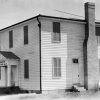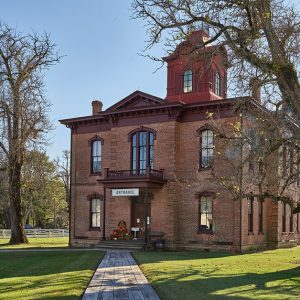calsfoundation@cals.org
Confederate State Capitol Building (Hempstead County)
aka: Hempstead County Courthouse of 1836
The 1836 Hempstead County Courthouse located in Washington (Hempstead County) was used as the Confederate State Capitol after Little Rock (Pulaski County) fell to Union forces in 1863. Today, it is one of the attractions of Historic Washington State Park.
In 1824, Washington was designated the county seat of Hempstead County; the seat had previously been located in the northeastern part of the county. By 1835, local officials recognized the need for a new county courthouse. The circuit court had previously met in a one-room building built by Tilman L. Patterson, who also supervised the construction of the new two-story courthouse. It was built in 1836 for $1,850. Between the time of its construction and the advent of the Civil War, the building was used not only for circuit court meetings but also hosted meetings of the Freemasons and held the office and records of the county clerk until a separate building for the clerk was constructed in 1839 by Daniel E. Alexander.
The 1836 courthouse served as the county seat of justice for nearly forty years. However, during that time, the condition and size of the courthouse often called for new buildings. As early as 1859, Judge Milton T. Holt was urged by many citizens to construct a new courthouse, so he appointed Robert D. Gibson, John A. Ely, and R. W. Price as commissioners to inquire into the possible cost of construction of a new courthouse, clerk’s office, and county jail. They presented their first plan for new buildings in 1860, and in January 1861 the county court discussed the need to fireproof the clerk’s office. Then, before any significant changes had been made, Arkansas seceded from the Union on May 6, 1861, changing the plans for a new courthouse in Hempstead County as people struggled just to survive the hardships of the Civil War.
The 1836 courthouse became significant to the state as well as Hempstead County after Little Rock fell to the Union army on September 10, 1863. Governor Harris Flanagin, upon hearing the news that Union troops were approaching Little Rock, gathered all of the state’s documents and moved the state government away from Pulaski County and eventually to the town of Washington. The 1836 courthouse served as the headquarters for Arkansas’s Confederate government until the end of the war. Although little business occurred there between 1863 and 1865, in September 1864, the Arkansas General Assembly, under Confederate authority, met at the courthouse under the pretense that it was important to hold special sessions to show the world that the refugee state government was still active. It met only a few more times before the end of the war. In 1866, Holt, now a former judge, was appointed commissioner of public buildings and ordered to carry out suitable repairs on the courthouse and clerk’s office, which had undergone considerable damage from the Twelfth Michigan Infantry occupying Washington after the surrender.
After the war, the building returned to use as a courthouse until a new one was built in 1874. The building served as a schoolhouse from 1875 to 1914, as a justice of the peace office and residence, and then as a museum. In 1922, the first unsuccessful attempt to preserve the structure was made, followed by a more successful venture by the United Daughters of the Confederacy (UDC) in 1928. From that time forward, the building was used as a museum and a place to hold meetings. In 1973, the building became part of Old Washington State Park (now Historic Washington State Park).
The 1836 courthouse was constructed on what was known as the Public Square on the corner of Franklin and Hamilton streets. The structure is that of a two-story braced frame with a low hipped roof and chimneys at either end. The building maintained a box-like appearance due to the proportion of the plan, which was arranged thirty-four feet by forty-four feet. It resulted in a nearly square shape, which architecturally is not known to have a pleasing appearance. The first floor consisted of an open courtroom containing two monumental turned wood columns. The upper floor consisted of a Masonic hall as well as several subordinate rooms, also supported by the two hand-carved wooden columns. However, like many buildings of the period, it underwent significant changes from its original appearance. Known changes from the original include the addition of a two-column Greek Revival–style portico added during the 1929 restoration by the UDC, which was removed by state park employees during their assessment of the property in 1993. The building was on the National Register of Historic Places on May 19, 1972, and was designated part of the Camden Expedition National Historical Landmark on April 19, 1994.
For additional information:
“Confederate State Capitol.” National Register of Historic Places nomination form. On file at Arkansas Historic Preservation Program, Little Rock, Arkansas. Online at http://www.arkansaspreservation.com/National-Register-Listings/PDF/HE0468.nr.pdf (accessed February 9, 2022).
Historic Washington State Park. http://www.historicwashingtonstatepark.com/ (accessed February 9, 2022).
Montgomery, Don. “History of the 1836 Hempstead County Courthouse.” Journal of the Hempstead County Historical Society 9 (Winter 1985): 9–21.
Southwest Arkansas Regional Archives. Washington, Arkansas.
Kayla Kesterson
Hot Springs, Arkansas
 Arkansas State Capital, Folkloric Relocations of the
Arkansas State Capital, Folkloric Relocations of the Union Occupation of Arkansas
Union Occupation of Arkansas 1874 Courthouse
1874 Courthouse  Confederate State Capitol
Confederate State Capitol 




Comments
No comments on this entry yet.